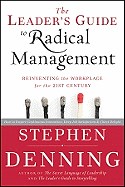An Excerpt from The Leader's Guide to Radical Management
November 01, 2010
We chose Stephen Denning's book, The Secret Language of Leadership, as the best book on leadership in our first annual business book awards in 2007. We first met him in 2008, when we were fortunate enough to have him come speak at our author pow-wow. We were so impressed by the talk he gave that, when we were planning this year's gathering, there was no question as to whether or not we'd invite him back.
Stephen's second book is The Leader's Guide to Storytelling and, below, we have an excerpt from the introduction to his new book, The Leader's Guide to Radical Management.
[The Leader's Guide to Radical Management] is a book about a radically different way of managing. It's about pulling apart the black box of traditional management and putting the pieces together in a way that creates continuous innovation and client delight. It involves a wholly different way of thinking, speaking, and acting at work. It leads to workplaces that are more productive and more fun. These workplaces feel different.
Given the deep change that has taken place in both the marketplace and the workplace, should we be surprised that we need different management today?
In the marketplace, what worked yesterday—satisfying customers by offering average products or services with zero defects—is no longer good enough. Absence of defects is expected and lacks luster. Unless clients are delighted, they can—and will—go elsewhere. The bar has been raised.
To ensure long-term growth, firms must forge relationships with their customers and turn them into long-term supporters and advocates of the firm's goods and services. They must continually find new and economical ways to provide goods or services that are differentiated, noteworthy, surprising, or remarkable. They need constant innovation.
Delighting clients goes beyond reconfiguring the marketing department. It means committing the entire organization, and everyone in it, to delighting clients as the firm's principal goal and putting in place the management principles and practices needed to accomplish that goal.
''Management was originally invented,'' management theorist Gary Hamel has noted, ''to solve two problems: the first—getting semiskilled employees to perform repetitive activities competently, diligently, and efficiently; the second—coordinating those efforts in ways that enabled complex goods and services to be produced in large quantities. In a nutshell, the problems were efficiency and scale, and the solution was bureaucracy, with its hierarchical structure, cascading goals, precise role definitions, and elaborate rules and procedures.''
With the continuing shift from semiskilled work to what economists call knowledge work, hierarchical bureaucracy is no longer a good solution. Its consequences are well known. It results in the talents, ingenuity, and inspiration of the workforce not being fully tapped. Only one in five workers is fully engaged in his or her work. For the organization, this means that the energies and insights of four out of five people in the workplace are being needlessly squandered. When the firm's future depends on what knowledge workers can contribute, leaving talent unused becomes a serious productivity problem.
For the customers of these organizations, the situation is similarly grim: a firm full of people who are not fully engaged in their work is not much fun to deal with. Although firms talk about customer service and responsiveness, they are more often engaged in one-way communications. The recorded message might say, ''Your call is important to us,'' but customers know that it isn't.
I argue in [The Leader's Guide to Radical Management] that the problems of today's workplace are not the personal fault of the individual managers. They are largely the fault of the system they are implementing, which relentlessly constrains the capacity of people to contribute, limits the firm's productivity, and practically guarantees that clients will be dissatisfied. The mental model of management that these companies are pursuing, with interlocking attitudes and practices, methodically prevents any individual management fix from permanently taking hold.
... I introduce a very different way of managing. I offer one extraordinary example after another: software developers, car manufacturers, house builders, staff in a call center, and songwriters, among others. And I will show people having serious fun in their work and becoming steadily better at doing it.
The emerging approach to managing is proving to be not only more productive than traditional management. It also liberates the energies, insights, and passions of people. It creates workplaces that enable the human spirit. It delights clients and creates shining eyes among the people doing the work.
This is not about firms becoming more productive by having people work longer hours or by downsizing or outsourcing. It's about deploying energies differently. In some areas, managers have to do more. In other areas, they need to do less. Overall they will have to act on the basis of principles that are quite different from those of today's traditional managers.
The seven principles I describe form a self-reinforcing sequence (see the figure below). Radical management begins by getting the goal right: the purpose of work is to delight clients, not merely to produce goods or services or make money for shareholders (Principle #1).
 Focusing on client delight leads to self-organizing teams, because client delight requires continuous innovation, and a self-organizing team is the management arrangement most likely to generate continuous innovation (Principle #2).
Focusing on client delight leads to self-organizing teams, because client delight requires continuous innovation, and a self-organizing team is the management arrangement most likely to generate continuous innovation (Principle #2).
This leads to working in client-driven iterations, because delighting clients can be approached only by successive approximations. And self-organizing teams, being life forms that live on the edge of chaos, need checkpoints to see whether they are evolving positively or slipping over the edge into chaos (Principle #3).
Similarly, client-driven iterations focus on delivering value to clients by the end of each iteration. They force closure and enable frequent client feedback (Principle #4).
Self-organizing teams that are working in an iterative fashion both enable and require radical transparency (Principle #5) so that the teams go on improving of their own accord (Principle #6).
An underlying requirement of all of these principles is interactive communication (Principle #7). Unless managers and workers are communicating interactively, using authentic narratives, open-ended questions, and deep listening, rather than treating people as things to be manipulated, none of the other principles work.
When self-organizing teams are set up and supported by implementing these principles, they naturally evolve into high-performance teams that are significantly more productive than the norm and deeply satisfying to workers.
Together the principles constitute a radical shift in the practice of management and an approach that is well adapted to meet the challenges of the twenty-first-century organization.
These principles comprise the seven most important elements of radical management. At the end of each chapter, I describe a large number of practices—more than seventy of them in total—that offer some of the ways to go about implementing the principles. Some practices support more than one principle.
The principles are more fundamental than the practices. If you think about the principles enough, you should be able to deduce the practices from them. If you keep the seven principles steadily in mind, you shouldn't go too far wrong.
Thus, in implementation, it's important to focus on the spirit of radical management and not get lost in the fine print. Even if you're not doing all of the seventy-plus practices yet are living the seven principles, that's still radical management. However, if you are doing lots of the practices but not living some of the principles, then you should probably ask yourself whether you still have at least one foot in the land of traditional management.
[The Leader's Guide to Radical Management] is not a book about praising famous firms or the current media darlings. Instead I discuss how ordinary people become extraordinary and how every firm can continuously reinvent itself. Rather than talking about prodigies or celebrities, I describe a way of working that is broadly available to all.
The organizations that I cite in the book have embarked on journeys. They are all at different stages of the journey, and none of them has in any permanent sense ''arrived.'' We will see more than one company that implemented the principles for a period and then lost its way. Implementing the principles requires constant energy and attention. I rarely use Japanese terms like kanban or kaizan, although Japanese firms have made an enormous contribution to management thinking and practice. My goal is to communicate certain truths that transcend any particular country or culture.
I also make sparing use of the terminology that is widespread in software development, under the labels of ''Agile'' and ''Scrum,'' with terms like scrum-masters, product owners, burndown charts, and sprints. Software developers deserve credit for advancing some of the thinking described in this book to its fullest extent. Their terminologies were deliberately chosen to differentiate this way of developing software from the roles and practices of traditional management. The terminology has been helpful in software development. My goal here is to explain in plain language how the underlying managerial principles and practices have roots in many different fields and apply to all sectors of the economy.
Some critics will say that the principles and practices I describe are not possible, that they embody an unbelievable utopia, or that they have already been tried and shown not to work. They will give a thousand reasons that we have no choice but to keep on managing the way we always have, with stunted productivity, dispirited workers, and frustrated customers.
It would be easier to accept that version of events if scores of organizations were not already practicing the principles of radical management and achieving extraordinary performance.
[The Leader's Guide to Radical Management] is intended for:
- Leaders and managers who want to reinvent the workplace and inspire extraordinary productivity, continuous innovation, deep job satisfaction, and client delight—all simultaneously
- Leaders and managers who want to lift their game and create organizations that buzz with extraordinary energy, excitement, innovation, and genuine high performance
- Leaders and managers who want to run established organizations with the energy and innovativeness of a start-up
- Anyone trying to understand how software developers practicing Scrum and Agile or manufacturers implementing lean production achieve extraordinary gains in productivity, and how to apply what they do to general management
- Anyone who wants to make leadership storytelling an integral part of the culture of an organization.
 ABOUT THE AUTHOR
Stephen Denning is a leading writer who consults with organizations in the U.S., Europe, Asia, and Australia on leadership, management, innovation, and business narrative. In 2009, he was a visiting fellow at All Souls College, Oxford University, U.K. He is the author of The Secret Language of Leadership—a Financial Times selection in Best Books of 2007, and a 800-CEO-READ selection as the best book on leadership in 2007.
Excerpted from The Leader's Guide to Radical Management by Stephen Denning.
Published by Jossey-Bass, a Wiley imprint.
Copyright © 2010 by John Wiley & Sons, Inc. All rights reserved.
ABOUT THE AUTHOR
Stephen Denning is a leading writer who consults with organizations in the U.S., Europe, Asia, and Australia on leadership, management, innovation, and business narrative. In 2009, he was a visiting fellow at All Souls College, Oxford University, U.K. He is the author of The Secret Language of Leadership—a Financial Times selection in Best Books of 2007, and a 800-CEO-READ selection as the best book on leadership in 2007.
Excerpted from The Leader's Guide to Radical Management by Stephen Denning.
Published by Jossey-Bass, a Wiley imprint.
Copyright © 2010 by John Wiley & Sons, Inc. All rights reserved.




